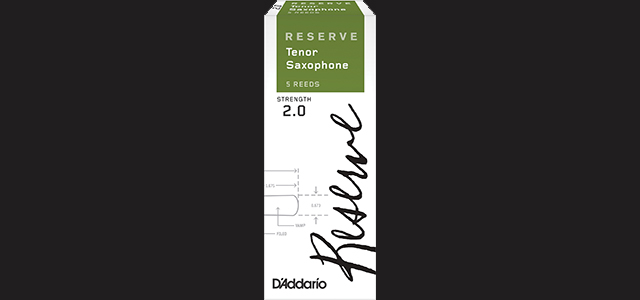When D’Addario’s Reserve Alto Saxophone Reeds hit the market in June 2014, they generated an incredible amount of positive feedback from some of the world’s top artists. Jim D’Addario, CEO of D’Addario & Co., Inc., is no stranger to reeds. As a child, he went to Mario Maccaferri’s French-American Reed Factory in The Bronx when his father delivered ukulele and guitar strings for Maccaferri’s famous plastic instruments. As a result, D’Addario’s commitment to manufacturing the best reeds on the market is no surprise. Recently, the company announced that it would expand its Reserve Saxophone line, coming to add Reserve Soprano and Tenor Saxophone Reeds. The line adds an important component to the company’s range of offerings, which already includes a diverse portfolio of products: guitar strings, drum heads, drum sticks, reeds, mouthpieces, etc.
Although the woodwind accessory market has certainly had its ups and downs since The Great Recession—a time when we’ve seen school budgets being cut left and right—the market does feel more secure these days. However, the number of competitors has increased, and D’Addario has definitely felt a continual need to stay ahead of the curve by making its products stand out from the rest. The company’s done this by fully digitizing its reed-making process with state-of-the-art machinery, enabling D’Addario to make reeds with a consistent quality that surpasses anything previously seen in the industry. The Retailer spoke to Chris Scialfa, Woodwinds Product Manager for D’Addario, to get some history and gain perspective.
According to Scialfa, D’Addario Reserve Reeds were the first D’Addario-branded woodwind product ever to hit the market. (Previously, the company’s woodwind products were branded as Rico, a company obtained by D’Addario in 2004.) First launched in June 2014 for the clarinet (with Reserve and Reserve Classic cuts) and the alto saxophone, D’Addario’s Reserve Reeds were conceptualized as a premier product for professionals and developing students; it was intended to be the most consistent reed on the market. Up to that point, cane reeds had been a challenge for players across the board. Owing to the inconsistency in manufacturing natural cane, only two or three good reeds would make it into a box of 10.
Historically, most European reed makers used machines built by the Franke Company by means of a method that utilized a steel model, or “cam,” to get the desired reed shape. (It’s similar to how a house key is made at a local hardware store.) A sharp blade would move back and forth, following the predetermined cam. Most French reed makers still use such machines today.
D’Addario’s process of making reeds starts in the south of France at the company’s own plantations, using organic practices. After that, each reed is digitally manufactured in California with machines designed and built by in-house engineers. With the digital platform, different geometric shapes, which older reed-making machines could not easily design, can be incorporated. The most important aspects of this process are quality of the cut, reliability and repeatability.
D’Addario sought a digital solution that could change from model to model…something that could utilize data-driven models instead of mechanical cams, which can wear and which need constant adjustment and maintenance. The company sought a solution that was free of variables, thus creating more product consistency and, as a result, improved marketplace viability. Between 2005 and 2006, the company designed and built all-digital reed-blanking machinery. The blanks, from this point, are separated and sorted, and then they enter the vamping process, which re-measures the blanks before cutting. Then, they are cut based on the machine’s digital programming, with specific measurements of the reed’s profile. The tip is measured for strength, it’s clipped and it passes built-in video inspection stations, which inspect both sides and from tip to heel. Then, the reed is slipped into a recyclable reed holder to be sorted by strength before going off to the packing line. The process removes many of the obstacles that previous methods entailed.
Since the introduction of the Reserve Soprano and Tenor Saxophone Reeds last summer, the feedback has been overwhelmingly positive. Most frequently cited are the sound they’re achieving, the consistency from reed to reed and the longevity of each reed. “Professionals also love the fact that we’re saving them time working with their reeds and trying to find the ideal one,” Scialfa said. “Now, they can devote that time to other aspects of their craft. And, educators love having their students on them, because they show immediate improvement to their sound, and they also create a more uniform sound within each section.”
Retailers looking to stock the most consistent reed on the market—complete with classy, clean packaging that looks good on display—will want to look into this competitively priced line. The Reserve Soprano and Tenor Saxophone Reeds are best suited for concert/classical players, and they’re ideal for professionals and developing students. The sopranos are currently available in boxes of 10 (MSRP: $46.00), whereas the tenors are available in boxes of five (MSRP: $36.00). Additional display options, including countertop displays, are available, as are samples (upon request).
Scialfa commented, “We’ve worked with some of the top musicians in the industry to ensure that each reed fits the demands of today’s players. I’m talking about J. Lawrie Bloom, Chicago Symphony; Mark Nuccio, Houston Symphony/New York Philharmonic; Richie Hawley, Rice University/Cincinnati Symphony; Tim McAllister, Northwestern University; Otis Murphy, Indiana University; and others.” He added, “We’ve managed to combine a wonderful cut with consistency, and that gives players confidence in our products. The best thing you can do is just to try them, so you can see, feel and hear for yourself!”



